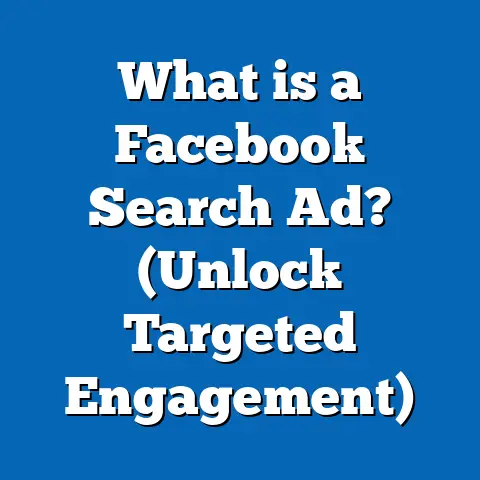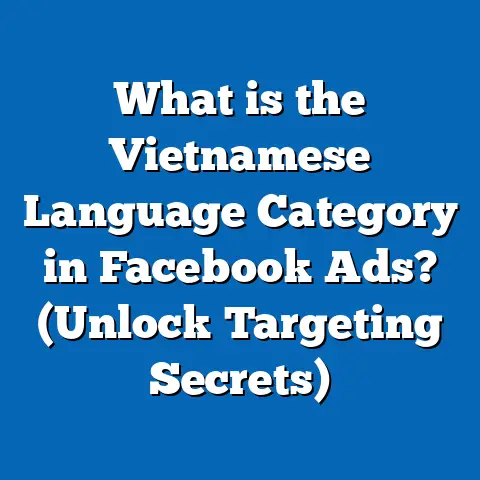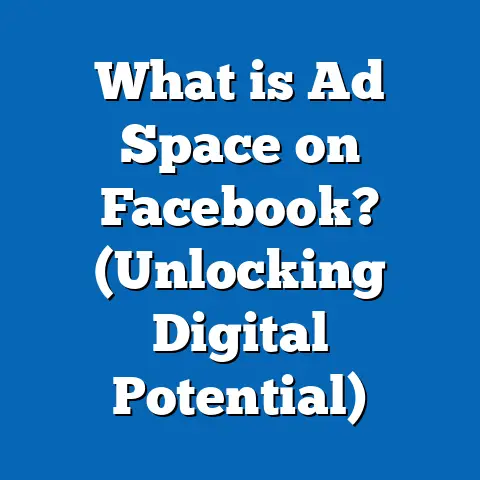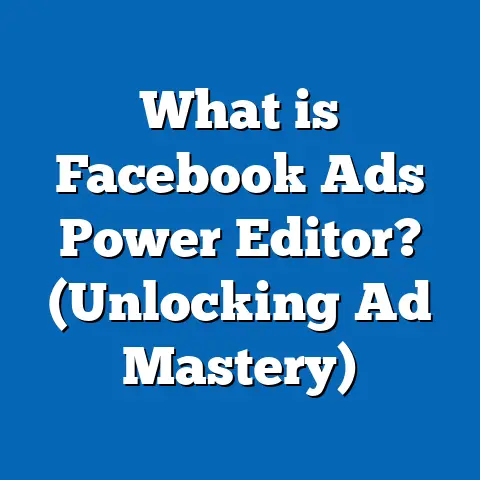What is Facebook Ad Strategy? (Unlocking Profitable Campaigns)
Introduction: Imagine Launching a Facebook Ad Campaign That Fails to Deliver
Picture this: You’ve just launched a new Facebook ad campaign with a sizeable budget, expecting a wave of new customers, leads, or sales. Days go by, but the results are underwhelming—low engagement, minimal clicks, and disappointing conversions. You wonder if your ad creative was compelling enough or if your audience targeting was accurate. Yet, the real issue might lie deeper—in the absence of a solid Facebook ad strategy.
The truth is, Facebook advertising can be a goldmine for businesses of all sizes when executed with precision. However, without a clear strategy based on understanding your audience and platform dynamics, even the best creatives and generous budgets can fail to deliver results.
This guide will equip you with everything you need to develop a winning Facebook ad strategy—from beginner basics to advanced optimization techniques. You’ll learn how to design campaigns that align with your business goals, leverage Facebook’s powerful tools and algorithms, and consistently unlock profitable results.
What Is a Facebook Ad Strategy?
A Facebook ad strategy is a purposeful plan designed to achieve specific marketing objectives using Facebook’s advertising platform. It encompasses audience research, creative development, budgeting methods, campaign structure, bidding strategies, optimization processes, and performance analysis.
Unlike simply “running ads,” a strategy focuses on harmonizing business goals with Facebook’s targeting capabilities and algorithmic delivery systems to maximize return on ad spend (ROAS).
Why Strategy Matters
Facebook’s advertising ecosystem is complex and highly competitive. With over 10 million active advertisers worldwide (source: Meta Q4 2023 report), standing out requires more than random ad placements or generic targeting. A structured strategy ensures your budget is spent efficiently on audiences most likely to convert while your ads deliver relevant messages that resonate.
The Facebook Advertising Landscape: Data and Trends
Understanding the environment you’re operating in is crucial for crafting an effective strategy. Here are some recent data points and trends illuminating the Facebook ads ecosystem:
- Over 2.9 billion monthly active users on Facebook globally (Statista, 2024).
- Average advertiser spends $1,200 per month on Facebook ads (WordStream, 2023).
- Average click-through rate (CTR) across industries is 0.90%, but top-performing campaigns achieve 2% or higher (WordStream).
- Mobile device impressions constitute over 94% of all Facebook ad views (Meta Internal Data).
- Video ads see 26% higher conversion rates than static images (Facebook Internal Study, 2023).
- The average cost per click (CPC) varies by industry, ranging from $0.50 in apparel to $3+ in finance (AdEspresso).
- Businesses using structured targeting and funnel-based campaigns report ROAS improvements from 2:1 to upwards of 5:1 (HubSpot, 2023).
- Facebook’s algorithm requires at least 50 conversion events per week for optimal learning and delivery (Meta best practices).
Core Components of an Effective Facebook Ad Strategy
Let’s break down the critical components that form the backbone of every successful Facebook campaign.
1. Defining Clear Objectives
Before launching any campaign, clarify what you want to achieve. Facebook offers multiple campaign objectives grouped into three main categories:
| Objective Category | Specific Options | Best For |
|---|---|---|
| Awareness | Brand awareness, Reach | Increasing visibility |
| Consideration | Traffic, Engagement, App installs, Video views, Lead generation | Driving engagement and interest |
| Conversion | Conversions, Catalog sales, Store traffic | Direct sales or leads |
Choosing the right objective influences how Facebook optimizes ad delivery. For example:
- Use brand awareness when launching a new product or entering a new market.
- Use conversions if you want users to complete purchases or sign-up forms on your website.
2. Audience Research and Segmentation
Audience targeting is where Facebook shines compared to many other platforms due to its rich data ecosystem. Effective segmentation helps avoid wasting ad budget on irrelevant users.
Types of Audiences
- Core Audiences: Defined by demographics (age, gender), location, interests (pages liked), behaviors (purchase habits), device usage.
- Custom Audiences: Upload your own data like email lists or retarget website visitors via Facebook Pixel.
- Lookalike Audiences: New users similar to your best customers based on behavior patterns.
Why Segment?
Segmented campaigns have shown up to 40% higher CTRs and conversion rates (HubSpot). For instance, segmenting audiences by purchase intent allows personalized messaging that speaks directly to their current buying stage.
3. Creative Development
Your ad creative—images, videos, headlines—is the first thing users notice. It must be compelling and aligned with your target audience’s preferences.
Creative Formats Available
- Image Ads: Simple but effective for direct offers or announcements.
- Video Ads: Engage better; absorb users’ attention longer; explain products well.
- Carousel Ads: Showcase multiple products or features in a single ad unit.
- Collection Ads: Combine video/image with product catalogs for immersive shopping experiences.
Creative Best Practices
- Use high-resolution images/videos optimized for mobile viewing.
- Include clear CTAs like “Shop Now,” “Learn More,” or “Sign Up.”
- Test different thumbnails for videos.
- Keep text concise; Facebook recommends less than 20% text overlay.
4. Budgeting and Bidding Strategy
Budgeting should be aligned with your campaign goals and expected returns.
Budget Types
- Daily Budget: A fixed amount spent per day; good for ongoing campaigns.
- Lifetime Budget: Total budget spread over campaign duration; offers more flexibility.
Bidding Options
- Lowest Cost (Auto Bid): Let Facebook optimize bids automatically for best results within budget limits.
- Cost Cap: Set a maximum acceptable cost per action to control spending but allow some flexibility.
- Bid Cap: Set fixed bids manually; requires experience for optimization.
Smart budgeting uses data signals from previous campaigns to allocate spend where it yields highest returns.
5. Campaign Structure and Funnel Alignment
Organizing campaigns according to the customer journey is crucial:
| Funnel Stage | Campaign Objective | Target Audience | Ad Examples |
|---|---|---|---|
| Top of Funnel (TOF) | Awareness & Engagement | Broad audiences; cold prospects | Brand videos; educational content |
| Middle of Funnel (MOF) | Traffic & Lead Generation | Warm audiences; website visitors | Product demos; testimonials |
| Bottom of Funnel (BOF) | Conversions & Sales | Hot audiences; cart abandoners | Discount offers; dynamic ads |
Advanced Strategies for Unlocking Profitable Campaigns
Leveraging Facebook’s Machine Learning Algorithms
Facebook’s algorithm optimizes ad delivery by learning which user profiles are most likely to convert based on conversion events tracked by the pixel or SDK.
- Optimal performance usually requires at least 50 conversions per week per ad set.
- Using Campaign Budget Optimization (CBO) allows Facebook to allocate budget dynamically across ad sets for maximum efficiency.
- Allow campaigns to run at least 3–7 days before making major changes to let algorithms learn effectively.
Example: A consumer electronics brand increased ROAS by 35% after switching from manual bidding to CBO combined with automatic placements across Facebook feeds and Instagram Stories.
Utilizing A/B Testing
Continuous testing is key to optimization:
What to Test
- Headlines and copy variations
- Images vs videos
- Different CTAs
- Targeting parameters (age groups, interests)
- Placement options
According to AdEspresso research, advertisers who systematically test see an average uplift of 77% in performance metrics such as CTR and conversion rate.
Retargeting Strategies
Retargeting warm audiences reduces acquisition costs significantly:
- Dynamic Product Ads show users items they viewed but didn’t buy.
- Video Retargeting re-engages users who watched part of your video but didn’t act.
- Sequential Retargeting delivers messages in stages aligned with customer behavior.
Studies show retargeting lowers cost per acquisition by up to 50% compared to cold prospecting campaigns (HubSpot).
Case Study #1: How a Mid-Sized E-commerce Brand Boosted Sales by 150%
Background: A mid-sized fashion e-commerce brand struggled with low conversion rates despite frequent advertising.
Strategy Implemented:
- Used segmented audiences for new visitors, engaged users, past purchasers.
- Created TOF video ads focusing on brand storytelling for awareness.
- Ran MOF carousel ads retargeting website visitors showcasing best sellers.
- Implemented BOF dynamic product ads offering discounts for cart abandoners.
- Leveraged the Facebook pixel for conversion tracking; used CBO for optimal budget allocation.
Results:
- Sales increased by 150% in three months.
- ROAS improved from 2:1 to 5:1.
- Cost per acquisition dropped by 35%.
Case Study #2: B2B Lead Generation Using LinkedIn vs Facebook Ads
While LinkedIn is often the default for B2B campaigns due to professional targeting, Facebook offers lower costs and more diverse ad formats.
Company: SaaS startup targeting mid-level managers.
Approach: Ran parallel campaigns on LinkedIn (higher CPC ~ $6) and Facebook (CPC ~ $2).
Findings:
- LinkedIn generated high-quality leads but at higher cost.
- Facebook generated more leads at a lower cost but required tighter targeting strategies like job title + company size + behavior filters.
- Combining LinkedIn’s professional focus with Facebook’s retargeting improved overall pipeline quality.
Comparing Facebook Ads with Other Platforms: When and Why
| Platform | Strengths | Weaknesses | Typical Use Cases |
|---|---|---|---|
| Facebook Ads | Detailed behavioral & interest targeting; variety of ad types; strong retargeting | Learning curve; ad fatigue risk | Brand awareness; e-commerce; retargeting |
| Google Ads | Search intent targeting; high buyer intent | Expensive CPCs in some verticals | Direct response; local services; immediate conversions |
| Instagram Ads | Highly visual; popular with younger demographics | Limited CTA options in some formats | Fashion; lifestyle brands; influencer campaigns |
| LinkedIn Ads | Professional targeting; B2B lead gen | Expensive clicks; limited creative options | B2B lead gen; recruitment campaigns |
Facebook’s flexibility and lower costs make it appropriate for most consumer-focused businesses plus many B2B marketers with creativity in targeting.
Key Metrics to Monitor for Facebook Ad Success
Tracking the right metrics lets you understand campaign health and optimize accordingly:
| Metric | What It Indicates | Industry Benchmarks / Notes |
|---|---|---|
| Click-Through Rate (CTR) | Ad relevance and user engagement | Average ~0.90%; higher is better |
| Cost Per Click (CPC) | Efficiency of clicks | Varies widely by vertical ($0.50-$3+) |
| Conversion Rate | Effectiveness at driving desired actions | Varies by industry & funnel stage |
| Return on Ad Spend (ROAS) | Profitability of ad spend | Aim for >3:1 for e-commerce |
| Frequency | How often users see your ad | Too high (>3) may cause fatigue |
| Cost Per Acquisition (CPA) | Cost to get one conversion | Lower CPA indicates better performance |
Practical Tips for Implementation
- Install the Facebook Pixel & SDK: Essential for tracking conversions accurately across web and app platforms.
- Build Custom & Lookalike Audiences Early: Use existing customer data before scaling.
- Use Campaign Budget Optimization (CBO): Simplifies budget distribution; often improves results.
- Regularly Refresh Creatives: Avoid ad fatigue by updating creative every 1–2 weeks.
- Test Video Ads: Videos perform well in engagement and conversions.
- Analyze Data Weekly: Focus on CTR, CPA, ROAS trends and adjust targeting or creatives.
- Use Automated Rules: Set alerts or automatic adjustments based on performance thresholds.
- Leverage Facebook Analytics & Attribution Tools: For multi-channel insights.
- Stay Updated on Policy Changes & Privacy Regulations: Comply with GDPR/CCPA/Apple iOS updates impacting tracking data.
- Experiment with New Features: Reels ads, Shops integration, Messenger ads can offer additional opportunities.
Latest Trends in Facebook Advertising (2024)
AI-Powered Creative Tools
Facebook increasingly integrates AI tools that help advertisers generate creative assets like headlines or video edits automatically based on performance data patterns.
Privacy-Centric Tracking Enhancements
With privacy laws impacting tracking accuracy, advertisers must leverage aggregated event measurement protocols and diversify attribution models beyond last-click.
Short-Form Video Ads Growth
Reels format continues gaining traction as users spend more time viewing short mobile videos—a prime opportunity for brands targeting younger demographics.
E-commerce Integration Expansion
Facebook Shops combined with Instagram Shopping allows seamless browsing and checkout directly within platforms—reducing friction in the buyer journey.
Step-by-Step Guide to Building Your First Profitable Facebook Ad Campaign
Step 1: Set Your Objective Based on Business Goals
Choose from awareness, consideration, or conversion objectives depending on whether you want broad exposure or direct sales.
Step 2: Define Your Target Audience
Use core audiences or upload custom lists; create lookalikes from high-value customers.
Step 3: Develop Your Creative Assets
Design engaging images/videos with clear CTAs aligned with audience preferences.
Step 4: Set Budget & Bidding Strategy
Start small with daily budgets while testing different bids—use automatic bidding if unsure.
Step 5: Structure Campaign According to Funnel Stage
Create separate campaigns/ad sets for TOF, MOF, BOF targeting distinct audience intent levels.
Step 6: Launch & Monitor Closely
Monitor performance daily initially—CTR, CPC, CPA—to identify early issues.
Step 7: Optimize Based on Data
Pause underperforming ads; increase budget on winners; test new creatives regularly.
Conclusion: Unlocking Your Profitable Facebook Ad Campaigns
Developing an effective Facebook ad strategy requires blending art with science—a clear understanding of your business goals combined with deep insights into your audience behavior and platform mechanics. By defining precise objectives, segmenting audiences thoughtfully, crafting compelling creatives, budgeting smartly, structuring campaigns aligned with your sales funnel, leveraging algorithmic optimizations, and continuously testing and refining your approach—you can unlock the full potential of Facebook advertising to grow profitable campaigns consistently.
Next Steps Checklist for Marketers and Business Owners
- <input disabled=”” type=”checkbox”> Define clear marketing objectives aligned with business goals.
- <input disabled=”” type=”checkbox”> Conduct thorough audience research using Facebook Audience Insights and other tools.
- <input disabled=”” type=”checkbox”> Install and configure the Facebook pixel and SDK correctly.
- <input disabled=”” type=”checkbox”> Develop multiple creative assets including videos and carousel ads tailored for different funnel stages.
- <input disabled=”” type=”checkbox”> Set up segmented campaigns aligned with your sales funnel stages (TOF/MOF/BOF).
- <input disabled=”” type=”checkbox”> Implement A/B testing frameworks for continuous improvement of creatives and targeting.
- <input disabled=”” type=”checkbox”> Monitor key metrics weekly—CTR, CPC, CPA, ROAS—and adjust strategies accordingly.
- <input disabled=”” type=”checkbox”> Stay updated on platform changes including privacy regulations and new feature rollouts like Reels ads and Shops integration.
- <input disabled=”” type=”checkbox”> Leverage automation tools such as CBO and automated rules for efficient campaign management.
- <input disabled=”” type=”checkbox”> Experiment regularly with new formats such as short-form video ads for engagement growth.






